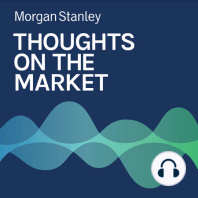3 min listen

Mike Wilson: Will the Equity Market Rally Last?
Mike Wilson: Will the Equity Market Rally Last?
ratings:
Length:
4 minutes
Released:
Nov 6, 2023
Format:
Podcast episode
Description
Last week’s uptick in stock prices, driven by a pullback in bond yields and the Fed’s decision to hold rates steady, is likely to fizzle over the coming weeks.----- Transcript -----Welcome to Thoughts on the Market. I'm Mike Wilson, Chief Investment Officer and Chief U.S. Equity Strategist for Morgan Stanley. Along with my colleagues, bringing you a variety of perspectives, I'll be talking about the latest trends in the financial marketplace. It's Monday, November 6th, at 10 a.m. in New York. So let's get after it. With many stocks down more than 20% from the July highs, a dynamic punctuated by tax loss selling from institutional managers at the end of October, equity markets were primed for some kind of a bounce. However, last week's rally in equities was the largest that we've seen all year, and it was led by many of the year-to-date laggards. Furthermore, both market cap and equal weight versions of the S&P 500 index were up 5.9%, as breadth showed its first signs of life since June. In our view, this move in equities was more about the strong rally in bonds than anything else. After an historic rise this past quarter, ten year Treasury yields reached an attractive level of 5% near the end of last month. Perhaps even more attractive for investors to ignore was that real ten year yields were at 2.5%. One factor driving bond yields lower last week was the Treasury's announcement of its planned longer term securities issuance that was below expectations. We also attribute the move to the weaker than expected economic data releases last week, more specifically, manufacturing and services purchasing manager surveys fell by much more than expected. The labor market data also showed further signs of cooling. Specifically, continuing jobless claims are now up more than 35% from the cycle trough, and the unemployment rate is now up 0.5% from the lows, both of these are important thresholds in past labor cycles. Finally, revisions to prior non-farm payroll data have consistently been negative this year, while the Household Labor survey indicated we lost 348,000 jobs last month. Given the absolute level of yields in a slowing growth and inflation backdrop, bonds may finally be attracting larger asset owners and allocators. Meanwhile, earnings revision breadth remains well into negative territory, with the big growth stocks earnings results providing only modest stability to this important leading indicator. This year's earnings recession continues to play out, particularly at the stock level. This is one reason why broader indices and the average stock's performance within the S&P 500 have been so much weaker than the very concentrated market cap weighted S&P 500 index this year. From a tactical perspective, the underlying performance breadth remains weak, while several broader and equal weighted indices remain flat on the year, with elevated volatility. A challenging risk reward set up in the context of 5% plus risk free yields that are currently available in money markets and T-bills. Yet the number one question we continue to get is whether there will be a rally into year end. For equity only asset managers, that's an important question and debate, but for asset owners and allocators, the prospect of adding additional equity risk at current levels seems unattractive given these other alternatives. The bottom line, we think the strong rally in rates drove stocks higher last week. Bulls have interpreted this move as a signal the Fed is done hiking rates and is likely to cut next year without any material deterioration to the labor market or some other negative event for growth. In contrast, we believe that the rate decline was mainly a function of less than expected, longer dated bond issuance guidance from the Treasury combined with some signs that the economy is slowing from the torrid pace of the third quarter. This is in line with our economists' tepid forecast for the fourth quarter and 2024 GDP growth and supports our view that
Released:
Nov 6, 2023
Format:
Podcast episode
Titles in the series (100)
Mike Wilson: How Confident Are U.S. Businesses in the Economy? by Thoughts on the Market